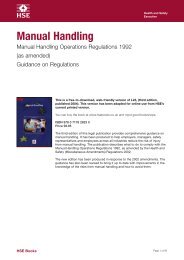Making Companies Safe - what works? (CCA ... - Unite the Union
Making Companies Safe - what works? (CCA ... - Unite the Union
Making Companies Safe - what works? (CCA ... - Unite the Union
Create successful ePaper yourself
Turn your PDF publications into a flip-book with our unique Google optimized e-Paper software.
However, even in <strong>the</strong> context of multi-fatality disasters, reputational damage and loss of<br />
customer / public confidence is only likely to occur after a regulatory body or public inquiry has<br />
found that a company bore full or part responsibility for <strong>the</strong> disaster, and made this finding<br />
public. 32 In conclusion, major ‘scares’, fatalities, enforcement notices and prosecutions are<br />
all – in Wright’s words – ‘symbols of failure’ that can impact negatively on a company’s<br />
reputation. However, as Wright argues, <strong>the</strong> level of regulation, frequency of contact with<br />
regulators and perceived effectiveness of regulator activities are all crucial to <strong>the</strong> detection of<br />
corporate failure and <strong>the</strong> allocation of fault. 33<br />
Audience Reaction and Business Impacts<br />
The creation of reputational risk as a driver for corporate compliance is dependent on <strong>the</strong><br />
existence of two fur<strong>the</strong>r conditions:<br />
• First, <strong>the</strong>re must be (and employers must believe <strong>the</strong>re to be) a high probability that one<br />
or more key ‘stakeholders’ will react negatively to <strong>the</strong> detection of any OHS failures. Key<br />
‘stakeholders’ could be: <strong>the</strong> public; employees, shareholders, customers or regulators.<br />
• Second, employers must believe that this negative reaction will have, or is likely to have,<br />
an adverse impact on business activity.<br />
The extent to which, and <strong>the</strong> way in which, stakeholders can affect business activity will<br />
depend on who <strong>the</strong> stakeholder is and also on <strong>the</strong> context within which <strong>the</strong> firm operates.<br />
For instance, a negative regulatory reaction could result in a prohibition notice and, <strong>the</strong>refore,<br />
a temporary suspension of business activity. A negative reaction by customers could result in<br />
loss of confidence in <strong>the</strong> business and/or its product and a subsequent decline in market<br />
share. However, <strong>the</strong> evidence suggests that <strong>the</strong>se impacts are far from certain, and are<br />
mediated by a number of o<strong>the</strong>r factors. Examples of some of <strong>the</strong>se factors are given below<br />
in relation to various stakeholders:<br />
Shareholder Reaction: Clearly a negative reaction by shareholders can affect business<br />
activity. Loss of shareholder confidence can lead to a range of economic effects, such as loss<br />
of shareholder value. The available evidence however suggests that shareholders are unlikely<br />
to operate as a driver for improved OHS performance on a day-to-day basis, since <strong>the</strong>y<br />
are not generally proactive on <strong>the</strong> issue of health and safety. For instance, only 1% of<br />
respondents to a UK survey involving 1,902 organisations cited ei<strong>the</strong>r shareholder, bank or<br />
parent company pressure as a reason for initiating OHS improvements within <strong>the</strong>ir<br />
organisations. 34 Similarly, recent research on OHS within <strong>the</strong> construction industry in <strong>the</strong> UK<br />
found that owners and shareholders were perceived by interviewees “to have little influence<br />
over health and safety”. 35<br />
On <strong>the</strong> o<strong>the</strong>r hand, shareholders might be expected to react strongly to large-scale disasters,<br />
making anticipation of shareholder reaction a greater motivator in high risk sectors. However,<br />
and perhaps surprisingly, <strong>the</strong> evidence suggests that shareholder reactions to disasters can<br />
have ei<strong>the</strong>r a negative or positive impact on business activity. Knight and Pretty analysed <strong>the</strong><br />
impact of fifteen major corporate catastrophes on shareholder value. They found that whilst<br />
<strong>the</strong> catastrophes initially had a significant negative impact on shareholder value <strong>the</strong>re was, on<br />
average, an apparent full recovery in just over fifty trading days. The ability to recover did<br />
however vary considerably between firms. The authors found that for those firms that<br />
recovered by <strong>the</strong> fiftieth trading day,<br />
“<strong>the</strong> average cumulative impact on shareholder value for <strong>the</strong> recoverers was 5%<br />
plus. So <strong>the</strong> net impact on shareholder value by this stage was actually positive.” 36<br />
In attempting to explain why shareholder value should, in some cases, actually increase<br />
following a major disaster, Knight and Pretty argue that:<br />
“Although all catastrophes have an initial negative impact on value,<br />
paradoxically <strong>the</strong>y offer an opportunity for management to demonstrate <strong>the</strong>ir<br />
talent in dealing with difficult circumstance.” 37<br />
74<br />
It appears <strong>the</strong>n that shareholders view health and safety management as distinct from <strong>the</strong>
















